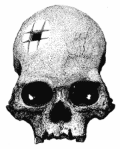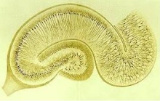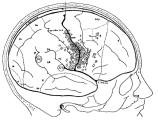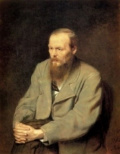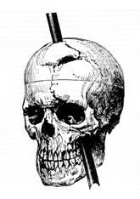March 3, 2010
Category: Neuroscience
THE perception and recognition of faces is crucial for the social situations we encounter every day. From the moment we are born, we prefer looking at faces than at inanimate objects, because the brain is geared to perceive them, and has specialized mechanisms for doing so. Such is the importance of the face to everyday life, that we see faces everywhere, even when they are not there.
We know that the ability to recognize faces varies among individuals. Some people are born with prosopagnosia, the inability to recognize faces, and others acquire the condition as a result of brain damage. At the other end of the scale are people who never forget a face - the so-called "super-recognizers". Two independent studies published recently now provide strong evidence that the ability to recognize faces is largely inherited, and that it is passed on independently from intelligence and other cognitive functions.
Read on »
Posted by Mo at 12:15 PM • 0 Comments • 0 TrackBacks
March 2, 2010
Category: Blogging
I 'M pleased to announce that my post about dinosaur brains and behaviour is featured in Open Lab 2009, the annual anthology of the best science writing on blogs. The book has just been published and is now available at Lulu.com, in hard copy or as a Kindle-compatible PDF.
This is the third Neurophilosophy post to be published in this series of books: my posts about the discovery of the neuron and the history of trepanation were included in the 2006 and 2007 editions, respectively.
This blog has also been selected as a finalist in the first annual Research Blogging Awards. I thought it might get into the category of Best Neuroscience Blog, but was very surprised to find it in the Best Research Blog category instead.
The expert panel of superstar science bloggers and writers who judged the awards assessed more than 400 nominees to select up to 10 finalists in each of the 20 categories. They consider their selections to be "the best of the best" in science blogging, so it's an honour to be included.
Voting for the awards opens on March 4th to all registered users of ResearchBlogging.org, who will be sent an email on that day inviting them to make their choices. If you're not a registerd user, there's still time to register so that you can vote.
Many thanks to everyone involved in the awards, and congratulations to all the other finalists. Thanks also to all who put together Open Lab and last, but certainly not least, to you, my readers.
Posted by Mo at 4:25 AM • 4 Comments • 0 TrackBacks
February 27, 2010
Category: Neuroscience
REMOVAL of specific parts of the brain can induce increases in a personality trait which predisposes people to spirituality, according to a new clinical study by Italian researchers. The new research, published earlier this month in the journal Neuron, provides evidence that some brain structures are associated with spiritual thinking and feelings, and hints at individual differences that might make some people more prone than others to spirituality.
Cosimo Urgesi of the University of Udine and his colleagues combined pre- and post-surgical personality assessments with advanced lesion mapping techniques to correlate changes in self-transcendence with brain structures in a total of 88 patients with brain tumours of different types and severity. 24 of the patients were being treated for high-grade glioma, which arises from astrocytes and is malignant; 24 had low-grade, or benign glioma; 20 were having a second operation to treat highly aggressive recurrent glioma; and 20 had meningioma, which arises in the membranes enveloping the brain but does not affect the brain itself.
Read on »
Posted by Mo at 3:58 PM • 9 Comments • 0 TrackBacks
February 19, 2010
Category: Developmental Biology
Click to enlarge
THIS cartoon by Dwayne Godwin, a professor of neurobiology at Wake Forest University School of Medicine, and Jorge Cham, the former researcher and cartoonist who created PhD Comics, has won first place in the informational graphics category of the 2009 International Science and Engineering Visualization Challenge.
The New York Times has a slide show of the winning entries, and today's issue of Science contains a special feature about the competition. To see the full size infographic, click on the image above, or visit Godwin's public engagement page, where it, and others in the same series, can be downloaded as PDFs.
Posts on brain development:
Posted by Mo at 6:20 AM • 10 Comments • 0 TrackBacks
February 18, 2010
Category: Neuroscience
WHEN it comes to making decisions, timing can be everything, but it is often beneficial to conceal the decision that has been made. Take a game of poker, for instance: during each round, the player has to decide whether to bet, raise the stakes, or fold, depending on the hand they have been dealt. A good player will have perfected his "poker face", the blank expression which conceals the emotions he feels and the decisions he makes from the other players sitting at the table.
Increasing numbers of researchers are using brain scanning techniques to perform what is commonly referred to as "mind reading". Their efforts have had limited success, however, and our decisions are still private mental events which are inaccessible to others. Until now, it was unclear whether there are outwardly visible physiological responses associated with the decision-making process. But a new study now shows that dilation of the pupils can predict when a decision has been made before an individual voluntarily reports making the decision.
Read on »
Posted by Mo at 11:30 AM • 3 Comments • 0 TrackBacks
February 4, 2010
Category: Neuroscience
IF a rapid series of taps are applied first to your wrist and then to your elbow, you will experience a perceptual illusion, in which phantom sensations are felt along the skin connecting the two points that were actually touched. This feels as if a tiny rabbit is hopping along your skin from the wrist to the elbow, and is therefore referred to as the "cutaneous rabbit". The illusion indicates that our perceptions of sensory inputs do not enter conscious awareness until after the integration of events occuring within a certain time window, and that the sensory events taking place at a certain point can be influenced by future events.
A group of Japanese researchers now shows that this illusion is not just confined to the body. In a new study published today in the Journal of Neuroscience, they report that the cutaneous rabbit can easily be induced to "hop out" of the body, so that the illusory sensations are perceived to originate not from the body itself, but from external objects that interact with it.
Read on »
Posted by Mo at 1:35 PM • 12 Comments • 0 TrackBacks
January 27, 2010
Category: Neuroscience
HOW does the brain encode the spatial representations which enable us to successfully navigate our environment? Four decades of research has identified four cell types in the brains of mice and rats which are known to be involved in these processes: place cells, grid cells, head direction cells and, most recently, border cells. Although the functions of most of these cell types are well characterized in rodents, it remains unclear whether they are also found in humans. A new functional neuroimaging study, by researchers from University College London, published online in the journal Nature, now provides the first evidence for the existence of grid cells in the human brain.
Grid cells were discovered in 2005 by Edvard and May-Britt Moser of the Kavli Institute for Systems Neuroscience in Trondheim, Norway, using multi-electrode arrays chronically implanted into the hippocampus and surrounding regions of freely moving mice. Whereas place cells fire when the animal is in a unique, specified position in its environment, grid cells - which are located in the entorhinal cortex - increase their activity in multiple locations, firing periodically as the mouse traverses a space. When a grid cell's activity is correlated with the animal's position and trajectory, and then superimposed onto a map of the environment, it is found to define a repeating pattern of equilateral triangles which 'tiles' the space (panel b, below). Each cell is activated whenever the animal's position coincides with any vertex in this grid, but each has its own periodicity, and so 'tiles' the environment using a unique scale.
Read on »
Posted by Mo at 12:40 PM • 3 Comments • 0 TrackBacks
January 23, 2010
Category: Neuroscience
"WHEN a man sits with a pretty girl for an hour," said Albert Einstein, "it seems like a minute. But let him sit on a hot stove for a minute, and it's longer than any hour." Einstein was describing one of the most profound implications of his Theory of General Relativity - that the perception of time is subjective. This is something we all know from experience: time flies when we are enjoying ourselves, but seems to drag on when we are doing something tedious.
The subjective experience of time can also be manipulated experimentally. Visual stimuli which appear to be approaching are perceived to be longer in duration than when viewed as static or moving away. Similarly, participants presented with a stream of otherwise identical stimuli, but including one oddball, or "deviant", stimulus, tend to perceive the deviant stimulus as lasting longer than the others. The underlying neural mechanisms of this are unknown, but now the first neuroimaging study of this phenomenon implicates the involvement of brain structures which are thought to be required for cognitive control and subjective awareness.
Read on »
Posted by Mo at 10:40 AM • 11 Comments • 0 TrackBacks
January 21, 2010
Category: Neuroscience
OUR ability to use and manipulate numbers is integral to everyday life - we use them to label, rank, count and measure almost everything we encounter. It was long thought that numerical competence is dependent on language and, therefore, that numerosity is restricted to our species. Although the symbolic representation of numbers, using numerals and words, is indeed unique to humans, we now know that animals are also capable of manipulating numerical information.
One study published in 1998, for example, showed that rhesus monkeys can form spontaneous representations of small numbers and use them to choose containers with more pieces of fruit. More recently, it was found that monkeys can perform basic arithmetic on a par with college students. Now, German researchers report that not only do rhesus monkeys understand simple mathematical rules, but also that these rules are encoded by single neurons in the rhesus prefrontal.
Read on »
Posted by Mo at 11:50 AM • 7 Comments • 0 TrackBacks


